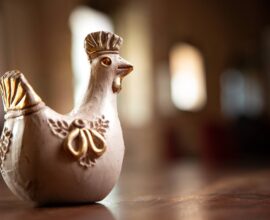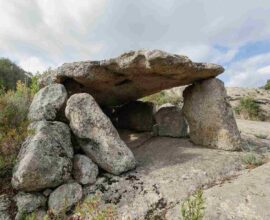Sa pasca nuntza: how’s Epiphany celebrated in Sardinia?
Between delicacies and centenary traditions: this is how the Epiphany is celebrated in Sardinia
There are few customs that have been handed down over the centuries to celebrate the day that “takes all holidays away”: among these, the preparation of the “Three Kings Cake”, strictly related to the Spanish Roscòn de Reyes, and its kàpidu ‘e s’ànnu, a sweet bread to be “broken” on the head of the youngest of the family.
Originated as a religious holiday, over the centuries the Epiphany has partly lost its original meaning, becoming more and more a commercial celebration: on the other hand, January 6th is now strongly associated with the arrival of the Befana, the famous old lady who, flying house to house with his broom, gives gifts to children who have behaved well by filling large socks with toys and sweets of all sorts. That said, some regional traditions actually stood the test of time: a nice example refers to the folk custom of Brusa la Vecia (“burning the old lady”), widespread especially in Veneto and in some places in Trentino-Alto Adige, which – as appears clear by the name – involves the burning of a massive puppet made up of rags and bundles of wood, a kind of propitiatory rite that marks the transition from the old to the new year. The same goes for the Sardinian territory, although the popular customs on the celebration of this holiday are generally less heartfelt than those related to Christmas, proudly handed down from family to family since the dawn of time.
What about Befana? Just a recently imported holiday
If for children “Befana comes at nighttime, with her all broken shoes”, as told in the famous nursery rhyme by Leonardo Tozzi, for others, such as the Sardinian anthropologist and philologist Francesco Alziator “Befana, of evident non-indigenous origin, it has submerged local traditions.” In short, sa femmina eccia or sa baccucca eccia (the most common epithets that Sardinians refer to the nice old lady who rewards good children between the night of January 5th and 6th), it has little to do with tradition local. Despite this, she has quickly become the children favorite – and not only.
A sort of cultural appropriation that it’s possible to learn about also in “Karalis: la città del sole”, among the main texts that deal with the culture and customs of the island. Nevertheless, it’s not so clear what these local traditions were. Among the few certainties that have survived to this day is that, since the Middle Ages, January 6th was indeed public holiday: in the Carta del Logu, a collection of Sardinian laws promulgated in April 1392, we can in fact read Sa pasca de sa epiphania si clamat pasca nuntza, where the term pasca stands for “feast” and nuntza recalls the annunciation of the birth of baby Jesus after the visit of the three Magi.
On the same day it was traditional to announce in church the dates of holidays without any prearranged day, such as Sa Pasca Manna, that is Easter, a holiday deeply heartfelt by the local population. Towards the end of the fifteenth century, with the annexation of the Sardinian territory to Spain, pasca nuntza began to lose its traditional link with the Carta del Logu, to be associated with the fiesta de los tres Reyes Magos then, very popular in the Iberian Peninsula, so much so that in the Sardinian language we still find some references to the sa Pasca de is tres Reis, that is “the festival of the three kings”. Thus, here’s the moment when reinterpretations of the Roscon de Reyes, or the “kings’ donut”, became part of the Sardinian food tradition linked to the celebration of Epiphany.
The Three Kings Pie: a delicious “lucky” tradition
Although the preparation requires a lot of time, care and passion, the “three kings pie” is certainly a pillar of the Sardinian Epiphany food tradition. Widespread throughout the island, with some typical variations from town to town, this dessert is faithfully inspired by the Iberian roscón de Reyes, a sort of long-leavened sweet donut made with flour, butter, eggs, orange juice, sugar and milk, which hides on the insides a dry bean (originally a coin) and the figurine of a king. Once cut into slices and distributed to the guests, the fun begins: whoever finds the hidden bean will have to pay the price of the dessert, while whoever finds the figurine will be elected the “king” or “queen” of the party and will have to be treated with all the honors and attention. Similarly, objects are hidden inside the dough of the “three kings pie”, usually a chickpea, a broad bean and a bean, as a symbol of prosperity and good omen for the lucky fellow diner who will find them inside their slice.
Su kàpidu ‘e s’ànnu, welcoming the new year with sweetness
Su kàpidu ‘e s’ànnu, known in some areas as sas Fikkas, seems to be a traditional food boasting much more ancient origin: it’s a crown-shaped focaccia of white bread on which 12 small suns or rings were/are engraved, each one representative of a month of the year. According to tradition, still heartfelt nowadays in the town of Benetutti (in the province of Sassari), the dessert was prepared during New Year’s Eve celebration and then broken on the head of the youngest member of the family during lunch on January 6th, a ritual to bid farewell to the old and happily welcome the new.
A similar ritual was also practiced for sa pertusìta or sa pertupìtta (from pertúpu, “pierced”), originally from the town of Nule (located in the Sassari area as well), a kind of sweet focaccia with a strong propitiatory value, which was usually given as a gift from owners to shepherds – it is no coincidence that it was often decorated with drawings of sheep and other animals.
Is animeddas, a tradition halfway between sacred and profane
Typical of the Alghero’s hinterland was the practice – still present today in certain villages – of carving the peel of some oranges with small floral or geometric motifs. These fruits were subsequently shown to neighbours and acquaintances by pronouncing the expression Nem’estrèna? (“no gift?”). In exchange, the luckiest could receive some coins or sweets. In other parts of the island, especially in the North, instead of showing off the citrus fruit, children and teenagers went from door to door singing the sos tres rese, the song of the three kings. To reward the show, the homeowners used to give them dried fruit, sweets and some coins. Bad luck was guaranteed to those who didn’t open the door or behaved rudely towards children. Both traditions recall Is animeddas, the festival of souls halfway between sacred and profane, which generally coincided with Halloween night (even if, curiously, the two celebrations seem to have developed independently).
Do you want to experience firsthand the magic of Sardinia’s rich folklore heritage and spend a fairytale holiday in a true paradise? Discover the Forte Village Resort in Sardinia






